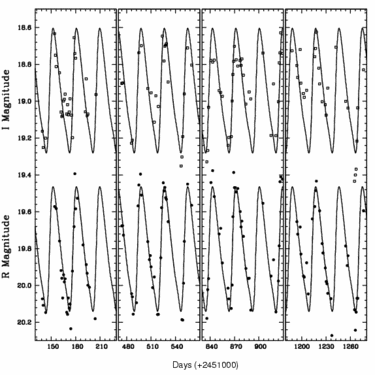



One of the fundamental problem in astronomy and cosmology is the measurement of distances of various celestial objects. Since the flux that we receive from any object varies as the inverse square of its distance from us; the basic understanding of any astronomical phenomenon crucially depends on its distance estimation. The most universally accepted standard candles are the Cepheid variables. These are further used as a primary distance calibrator for the secondary standard candles which applies at much greater distances.
Since the search of gravitational microlensing events requires monitoring of millions of stars over a few years to yield a significant number of microlensing events, consequently, it produce a massive multi-band photometric database that provides unique material for studying stellar variability. A large number of Cepheid variables are already reported in the various Microlensing surveys
During 1998-2002, we have carried out observations using 1.04-m telescope at Nainital to detect microlensing events in the direction of M31. The target field centered at RA = 00:43:38, DEC = +41:09 and covered an area of about 13x13 square arcmin field using 2Kx2K CCD chip in the disk of M31.
During the four years long survey, the photometric study of about 4400 resolved stars down to ~ 21 mag, have been carried out and a comparison of magnitudes determined in our photometry is in agreement with those available in literature. We have searched variability among these stars and 359 of them were identified as the variable stars. Out of this, we found 26 Cepheids, 115 periodic variables, 2 possible eclipsing binaries and remaining 216 stars as a semi-regular or long period variables. Of the 26 Cepheids, two are newly discovered, 11 are classified as Cepheids for the first time and 13 are confirmed as Cepheids. Two Cephieds are suspected as a population II Cepheids and remaining 24 Cepheids are identified as a population I (classical) Cepheids. The extensive photometry of these Cepheids enabled us to determine precise period and amplitude of pulsation which varies from 0.11 to 0.48 mag in R band. The period of variability in these Cepheids ranges from ~ 7.5 to 56 days. The Cepheids range in age from 22 Myrs to 75 Myrs. The locations of the Cepheids indicate that most of them are centered towards the bulge direction of M31, where, possibly, the star formation was active a few million years ago.
The period-luminosity diagram is used to derive a distance modulus of 24.49+/-0.11 mag for M31 using 24 classical Cepheids detected in the present study which corresponds to a distance of 790+/-45 kpc for the M31 galaxy.
The figure in the left side is photometric light curves for a classical Cepheid in RI bands monitored during Nainital Microlensing Survey. Period of the Cepheid is 28.28 d.
(see detail on Joshi et al. (2003) .and. Joshi et al. (2010))
Dr. Yogesh C. Joshi
Scientist-F
Aryabhatta Research Institute of Observational Sciences (ARIES)
Ministry of Science and Technology, Govt. of India
Nainital-263001
India
Office Room: 125
New Building, First Floor
Office Phone: +91-(0)5942-270754
Office Extn.: 754
Email: yogesh@aries.res.in
Last modified Tuesday, 01 July 2025